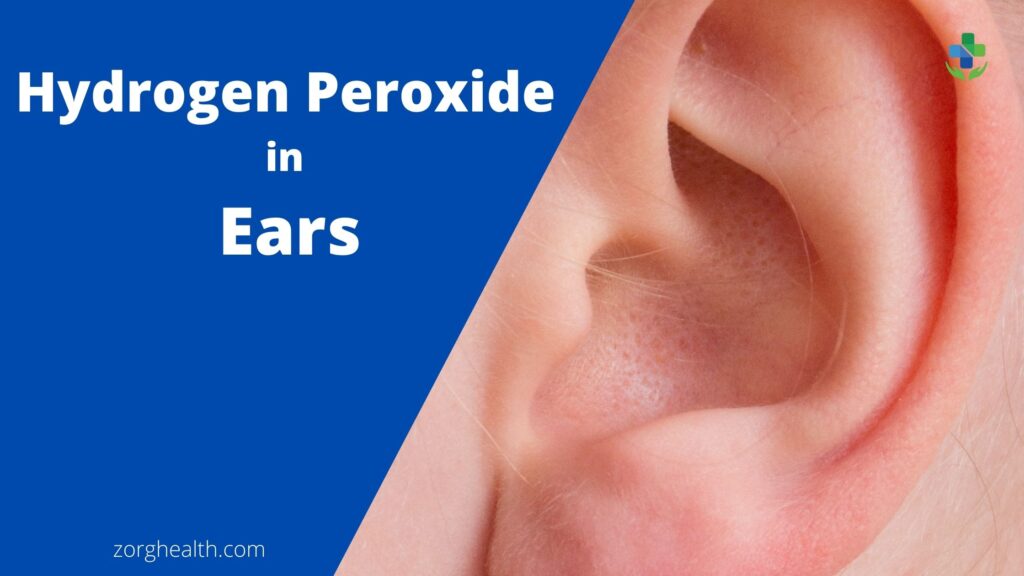Hydrogen peroxide is a versatile and readily available chemical liquid commonly used as an ingredient in many cleaning products, antiseptics, disinfectants, etc. Due to its easy availability, antiseptic properties, and powerful oxidizing agent, many people prefer to keep it as part of their medicine cabinet or first aid kit. Let’s understand is it safe to use Hydrogen Peroxide for the Ears or Not.

Hydrogen peroxide has been used as a natural remedy for earache for a long while.
While hydrogen peroxide may have a variety of potential uses, ideally it should be used only as a disinfectant—containing a safe amount of hydrogen peroxide for safety concerns.
Relevance of Hydrogen Peroxide in Ears
Earwax plays an essential function as a natural cleanser in the ears by removing dead skin cells, dirt, hair, etc. from the ear canal. Earwax with antifungal, antiseptic and antibacterial properties also help to minimize ear infections, reduce irritation when water enters the ear canal, and thus prevent the ear canal from feeling uneasy.
However, excessive build-up of earwax can block the ear canal causing multiple problems like ear infections, earaches, ear discharge, hearing difficulties, ear itchiness, ringing in the ears, etc.
Many people tend to use foreign objects like cotton swabs to clean the excess earwax—not recommended. Several safe methods of managing excess earwax are available.
During such blockages from earwax, hydrogen peroxide is a common ingredient in Over-the-Counter (OTC) ear drops to soften, dissolve and bubble up the earwax. Using ear drops is one easy and effective method to remove excess earwax by allowing the wax to dispel on its own.
Although earwax irrigation is one of the most common treatments for cleaning earwax, research advocates eardrops as a first-line treatment to help ears self-clean as they generally have less room for error and are considered a safer option.
Side effects of Hydrogen Peroxide in Ears
Hydrogen peroxide in the ears usually leads to no negative side effects. However, it can cause problems if a person has a prior medical condition of the ears.
Following are some of the side effects of using hydrogen peroxide in ears:
-
Can cause skin irritation inside the ear canal (if used frequently)
-
Can cause skin burns and blistering (if used in higher concentrations i.e over 10%)
-
Can cause ear pain (if ear tubes are inserted or have perforated eardrum)
-
Can cause temporary hearing loss
-
Can cause ringing of the ears
-
Can cause dizziness
-
Can cause temporary bubbling sensation
-
Can cause gastrointestinal related irritation
-
Can lead to other problems (inflammation, vomiting, respiratory paralysis, etc.)
Be mindful of usage of Hydrogen Peroxide in the Ears
Here are some of the points to consider.
-
Avoid exposure to strong concentrations of hydrogen peroxide.
-
Ensure to not ingest, inhale, or get the liquid on the skin/eyes.
-
Always follow the manufacturer’s packaging instructions when using ear drops.
-
Always consult a doctor’s advice before using ear drops and their dosage.
Cases in which to Avoid using Hydrogen Peroxide for the Ears
In the cases of the following events, don’t use hydrogen peroxide in their ears:
-
Who has had a recent ear surgery
-
Who have ear tubes or ventilation tubes
-
Who have open cuts in their ear canal
-
Who may have a ruptured eardrum
-
Who likely has an ear infection
How to Use Hydrogen Peroxide eardrops in ears
A common method for earwax removal is to squeeze a few drops of hydrogen peroxide through the eyedropper into the ear canal. You can also use a damp cotton ball and apply it to the affected ear.
It is essential to tilt the head or lie down to one side so that the affected ear is pointing upward for several minutes. This will allow the fluid to penetrate the ear canal to reach the ear wax/blockage.
After a few minutes, tilting the head the other way will allow the fluid and earwax to drain into a towel until the ear canal is clear. You can also flush out excess hydrogen peroxide and earwax with warm water or a bulb syringe. Don’t put more than 10 drops in the ear at one time. Do this once a day for 3 to 14 days.
The Bottom Line
While earwax is important to trap debris and contaminants into the ear, it may also become clogged or trap water behind the wax.
People can remove excess earwax in several different ways. Using ear drops is one easy and effective method. Many commercially available ear drops contain hydrogen peroxide.
Hydrogen peroxide has been considered an effective ingredient in earwax removal solutions for many years. In general, hydrogen peroxide has a good safety profile if used properly.
Hydrogen peroxide is generally safe at low concentrations. Avoid using a strong concentration of hydrogen peroxide or using it too frequently. This can irritate the ear and result in complications.
Anyone uncertain about their ear infection status should check with a doctor before using hydrogen peroxide in their ears.
